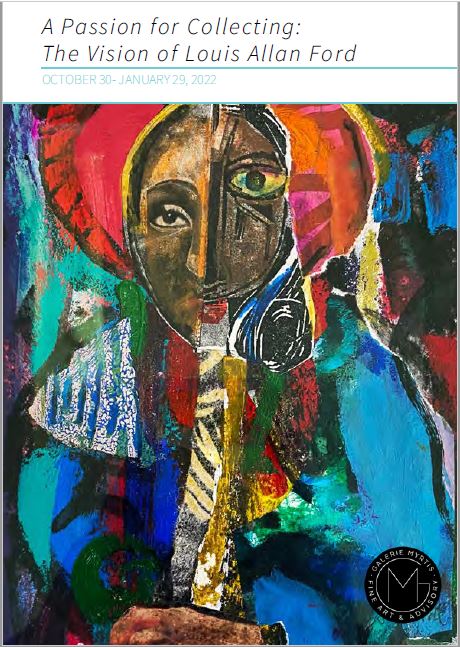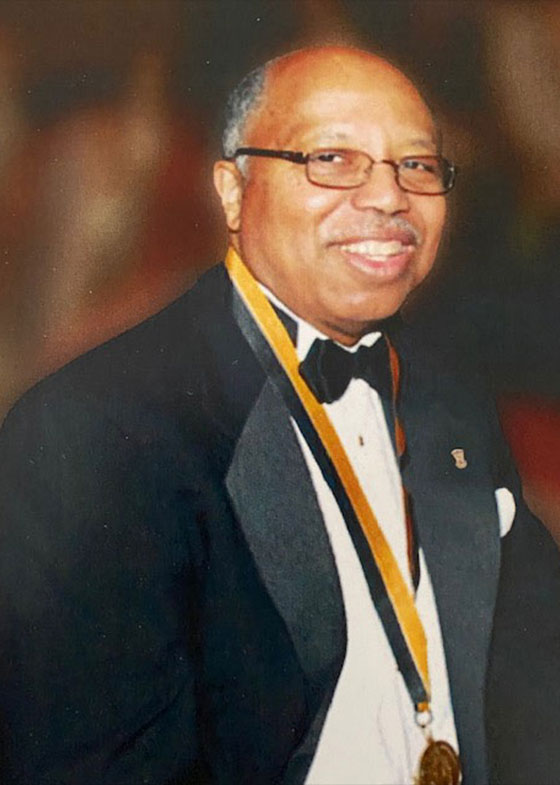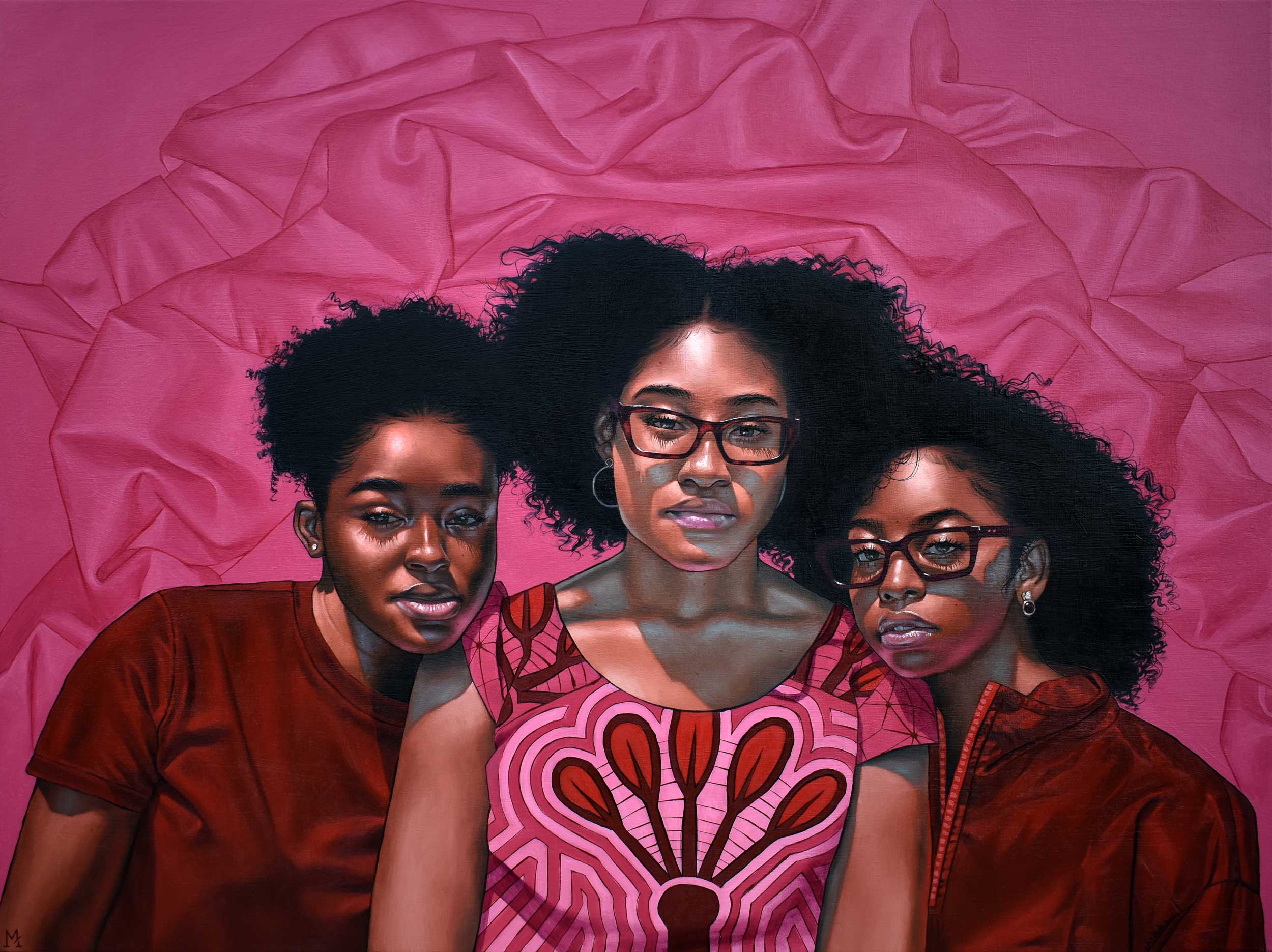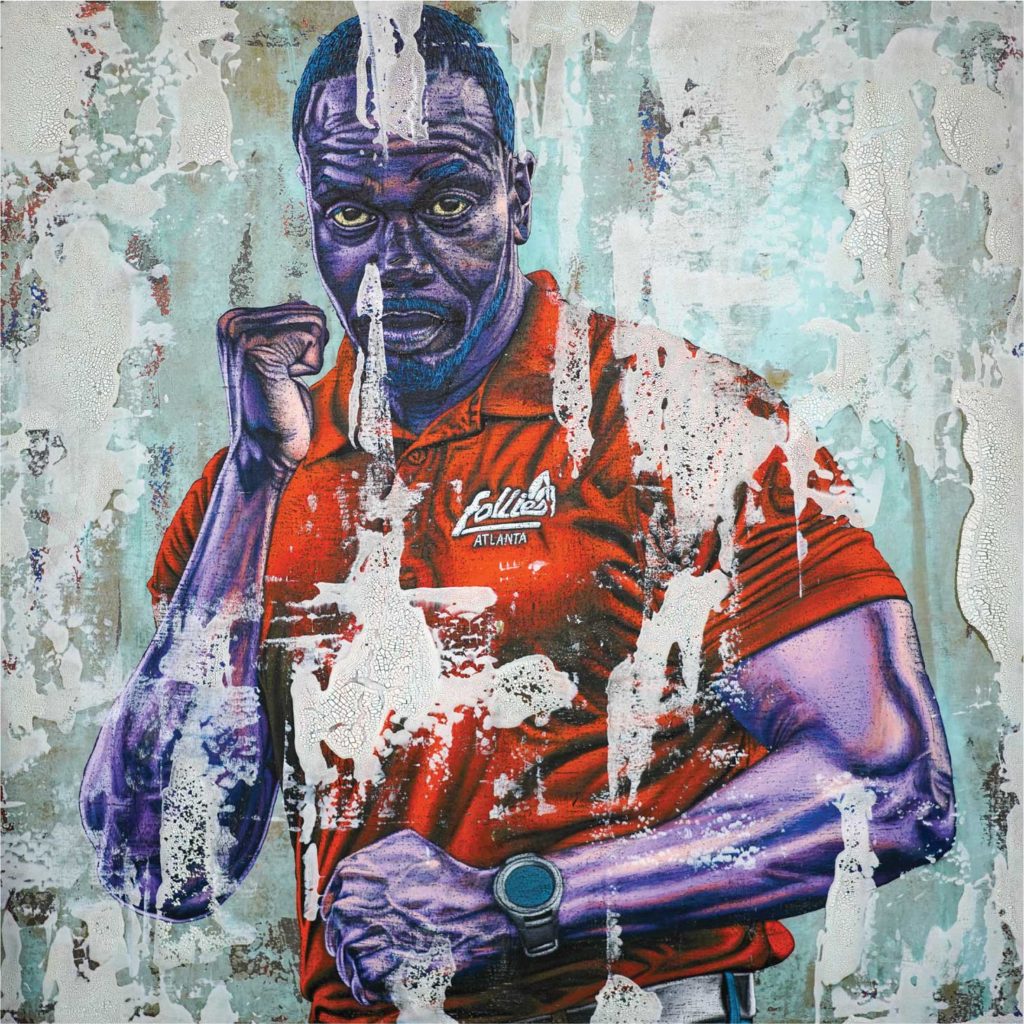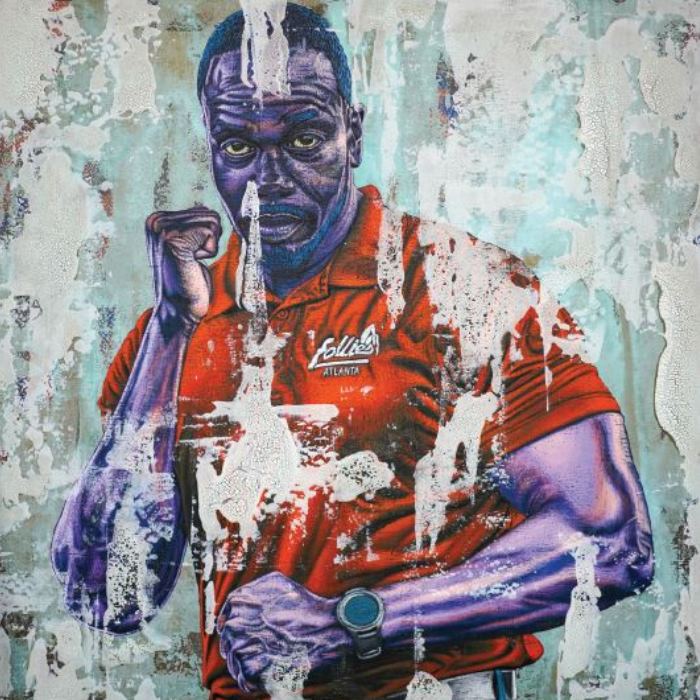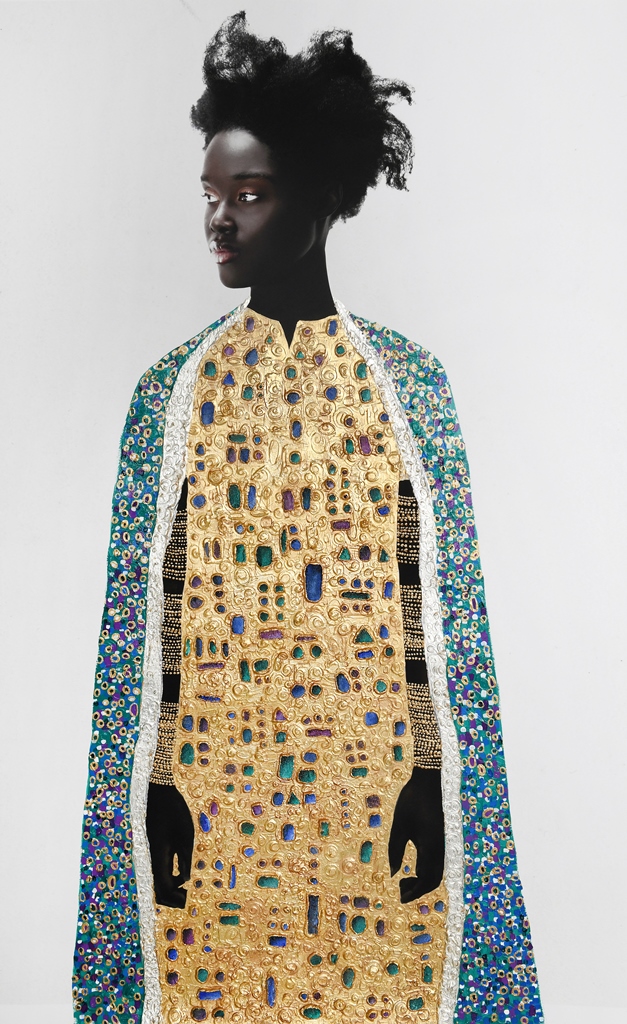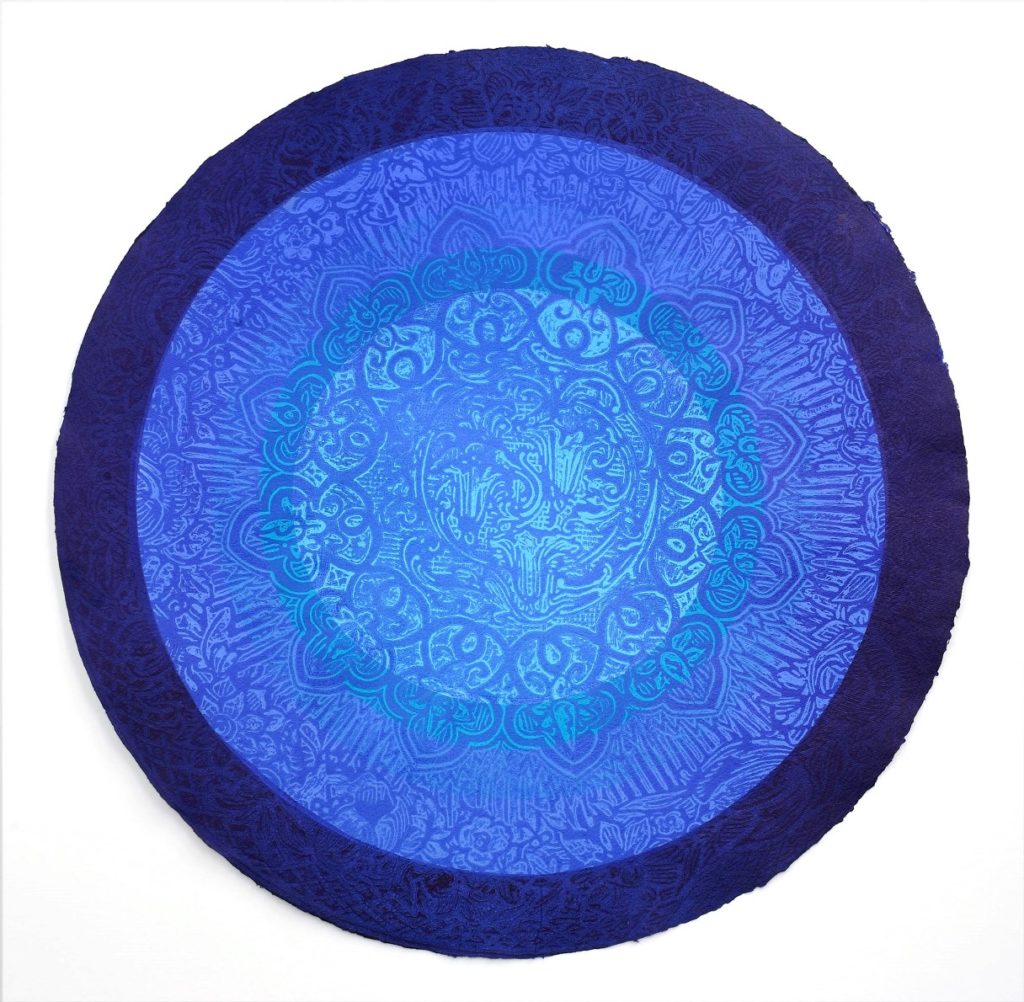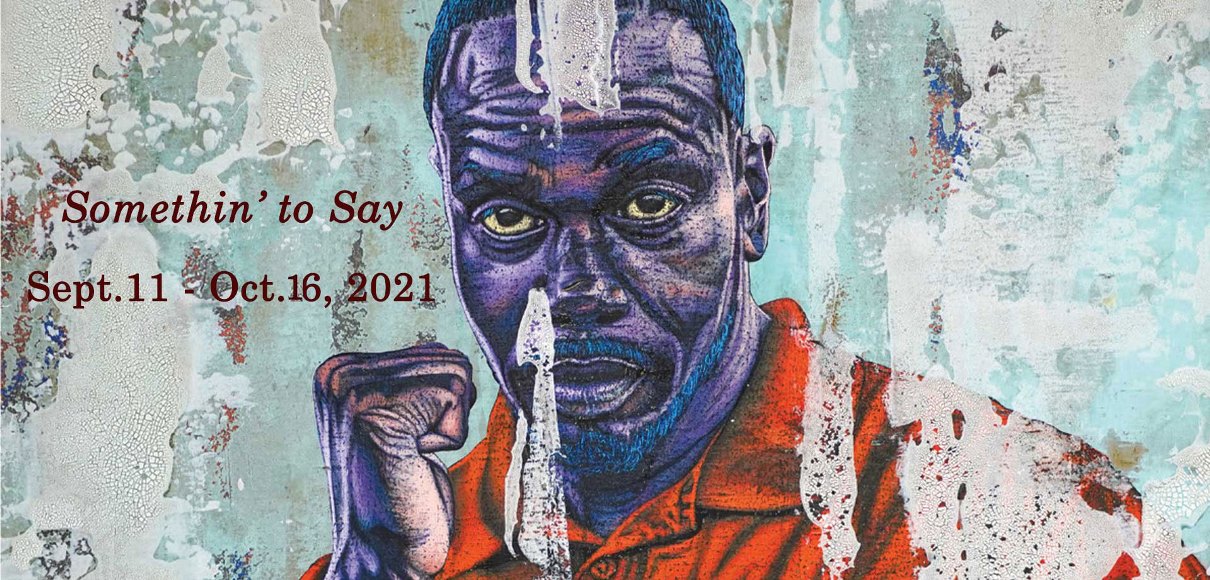
Isiah (The Boxer, The Bouncer), acrylic and atomized, bronze dust on canvas, 60 x 60 x 2.5 in., 2021, by Alfred Conteh
About the Artists
view artwork | read curatorial statement
Alfred Conteh
Alfred Conteh (b. 1975, Warner Robins, Georgia) is a classically trained artist, who has practiced his craft for more than 20 years. After earning a Bachelor Degree in Fine Arts from Hampton University, Conteh continued his formal education at Georgia Southern University; earning a Master’s Degree in Fine Arts. As an African American artist, Conteh sheds light on the current realities of African American people; by bringing their stories and experiences to the forefront. Conteh’s creative techniques range from paintings to drawings and sculptures to assemblage works. His artwork can be found in public and private collections throughout the world.
In 2018, Conteh was commissioned by the Smithsonian Institution Traveling Exhibition Service (SITES) to create a portrait of film director, producer, and screenwriter Ryan Coogler. The portrait titled Home Team is featured in the traveling exhibit Men of Change: Power. Triumph. Truth. The exhibit pays tribute to African American changemakers for their outstanding legacy and contributions.
Conteh’s work in the permanent collections of the Arkansas Arts Center, Little Rock, AR; Bajeel Art Foundation, Dubai, United Arab Emirates; Minneapolis Institute of Art, Minneapolis, MN; Museum of Arts and Sciences Permanent Collection, Macon, GA; Petrucci Family Foundation Collection of African American Art, Ashbury, NJ; Tubman Museum Permanent Collection, Macon, GA; Georgia Southern University Permanent Collection, Statesboro, GA; Georgia Southwestern University Permanent Collection, Swainsboro, GA; Hammonds House Museum Permanent Collection, Atlanta, GA; United Talent Agency, Beverly Hills, CA; and United Way Corporate Collection, Atlanta, GA
Larry Cook
Cook has exhibited his work nationally at the Smithsonian National Portrait Gallery (2019), National Gallery of Art (2017), and the Baltimore Museum of Art (2016), and internationally during the 13th Havana Biennial. Among Cook’s recent prestigious awards is the Trawick Prize (2020). He was a finalist for the Outwin Boochever Portrait Competition, Smithsonian National Portrait Gallery, Washington, D.C. (2019), and a two-time Janet and Walter Sondheim finalist in (2013 and 2016).
Cook’s photography was featured as a large-scale public installation Ceremonies of Dark Men, part of the 5 X 5 Project, organized by the D.C. Commission on the Arts curated by AM Weaver (2014). As the recipient of several artist-in-residency and fellowship programs, Cook has participated in the Nicholson Project Artist-in-Residency, (2020) Savage-Lewis Residency, Art on the Vine in Martha’s Vineyard (2018), and Washington Project for the Arts Residency (2017). He completed a fellowship at the Hamiltonian Gallery (2013-2015). Cook is currently an Assistant Professor of Photography at Howard University.
T.J. Dedeaux-Norris
T.J. Dedeaux-Norris fka Tameka Jenean Norris was born in Guam and received their undergraduate degree at the University of California, Los Angeles before graduating with an MFA from Yale University School of Art. Dedeaux-Norris has recently participated in numerous exhibitions and festivals including at Nasher Museum of Art at Duke University, Durham, NC; Yerba Buena Museum, San Francisco, CA; Prospect.3 Biennial, New Orleans, LA; The Walker Museum, Minneapolis, MN; Performa 13; Contemporary Arts Museum Houston, Houston, TX; The Studio Museum, Harlem, NY; Rotterdam Film Festival, Rotterdam, Netherlands; Sundance Film Festival, New York, NY; Mission Creek Festival, Iowa City, IA among many others. Dedeaux-Norris has participated in residencies at the Skowhegan School of Painting and Sculpture, the Fountainhead Residency, Grant Wood Colony Fellowship, The MacDowell Colony, Vermont Studio Center, and Yaddo. They are the 2017 recipient of a National Endowment for the Arts grant, a 2018 National Endowment for the Arts fellowship, a 2019-2020 Pollock-Krasner Foundation grantee, and is currently tenure track Assistant Professor at the University of Iowa.
Nathaniel Donnett
Nathaniel Donnett is a cultural practitioner who lives and works in Houston, Texas. Donnett received his BA in Fine Arts from Texas Southern University and his MFA from Yale University School of Art. Donnett is a recipient of a 2020 Dean’s Critical Practice Research Grant, 2020 Art and Social Justice Initiative Grant, and the 2020-2021 Helen Frankenthaler Scholarship. Donnett has been awarded a 2017 Houston Arts Alliance Individual Artist Grant, a 2014 Harpo Foundation Grant, a 2015 Idea Fund/Andy Warhol Foundation Grant, and a 2010 Artadia Award. His work has been shown at The Virginia Museum of Fine Art, Richmond, VA, The Virginia Museum of Contemporary Art, Virginia Beach, VA, The Mennello Museum, Orlando FL, The Ulrich Museum, Wichita, KS, The McColl Center, Charlotte, NC, The American Museum, Washington, DC, The Kemper Contemporary Arts Museum, Kansas City, MO, Harvey B Gantt Art Center for African American Arts and Culture, Charlotte, NC, The Community Artist’s Collective, Houston, TX, The Mattatuck Museum, Waterbury CT, The Contemporary Arts Museum Houston, Houston, TX, Project Row Houses, Houston, TX, The University Museum, Houston, TX, and The New Museum, New York, NY.
Yashua Klos
Yashua Klos (b.1977, Chicago) is an artist best known for his large-scale collage works which address issues of identity, race, memory and community.
Influenced by his upbringing in Chicago’s South Side, Klos challenges the construction and conventions of African-American identity. Notions of marginalization, masculinity, and urban mythology are unpacked through examining behaviors within communities. He uses portraiture to highlight narratives of suppression, denial, and pain associated with the vulnerability experienced in black communities; and pins this against stoic performances of adaptation and thriving.
Klos finished his Master of Fine Arts at Hunter College in New York in 2009, after studying his undergraduate degree at Northern Illinois University. He has been awarded residencies at the Skowhegan School of Painting and Sculpture, Skowhegan; The Vermont Studio Center, Johnson and Bemis Center for Contemporary Arts, Omaha. He is the recipient of a 2014 Joan Mitchell Fellowship and a 2015 NYFA Grant.
Michi Meko
In the summer of 2015, I almost drowned. Inviting this life-changing event’s influence into my studio practice, my recent paintings and sculptures focus on the African American experience of navigating public spaces while remaining buoyant within them. This work contributes to an important conversation, as African Americans in public space are consistently threatened, now more visibly and openly with the evidence and sharing offered by social media. This barrage of images simulates an experience of drowning under the heavyweight of ten thousand pounds of pressure while being held to the ocean’s floor.
The work incorporates the visual language of naval flags and nautical wayfinding, combined with romanticized objects of the American South as a means to communicate the psychological and the physical. These references signal the warning of a threat or the possibility of safe passage. Working beyond the physical image of the body, objects of buoyancy and navigation become metaphors for selfhood, resilience, and the sanity required in the turbulent oceans of contemporary America.
The use of navigation is one of the skills required for any journey. At a youthful age, this knowledge is taught through oral history and becomes the framework for understanding past and a present mobility. It is the necessary visual device for future expeditions and one’s survival.
Lester Julian Merriweather
Lester Julian Merriweather (b.1978) is a Memphis-based visual artist. He attended the Skowhegan School of Painting & Sculpture. He holds an MFA from Memphis College of Art and a BA from Jackson State University. Merriweather has exhibited extensively throughout the U.S. at various venues such as the Studio Museum in Harlem, NYC, TOPS Gallery, CrosstownArts and Powerhouse Memphis, Diverseworks in Houston, Stella Jones Gallery in New Orleans, and the Atlanta Contemporary. He has also exhibited abroad at the Zacheta National Gallery in Warsaw, Poland. Merriweather served as the first Curatorial Director of the Jones Gallery & the Martha & Robert Fogelman Galleries of Contemporary Art at the University of Memphis from 2010-2015. He worked on the Board of Directors for Number, Inc. independent journal where he created the Art of the South Exhibition Series. He is a founding member of the ArtsMemphis Artist Advisory Council and the artsAccelerator Grant Panel.
Merriweather is currently Emeritus for the Advisory Panel of TONE Memphis. He served as the first Curatorial Consultant for the PPF Contemporary Art Collection in Memphis, Tennessee.
Vitus Shell
Vitus Shell (b. 1978, Monroe, LA) is a mixed-media collage painter born in Monroe, LA, where he lives and works. His work is geared toward the black experience, giving agency to people from this community through powerful images deconstructing, sampling, and remixing identity, civil rights, and contemporary black culture. He received a BFA from Memphis College of Art, 2000 and an MFA from the University of Mississippi, 2008.
Slim Crow
My current works are geared toward the black experience, giving agency to people from this community through powerful images deconstructing, sampling, and remixing identity, civil rights, and contemporary black culture. In my work, I strive to bridge the gap between the older and younger generations by exploring and uncovering factors that contributed to the unfortunate relationship breakdown between the two. Moreover, my layered, mixed media paintings examine parallels between present-day behaviors and attitudes that date back to African roots. With this work, I continue experimenting with portraiture, acrylic paint, oversized photocopies of early 20th-century vintage advertisements, and the incorporation of a foam-cut printing technique. My artistic goal is to exude the hip-hop lifestyle with a southern vernacular.
Through the use of the vintage, advertisements allow me to create narrative-based environments, which comment on stereotyping, bigotry, and oppression. The foam cut printing method provides me with the added layers to include text and icons, such as the minstrel images. Having spent much time researching graffiti art, I incorporate a variety of its characteristics, techniques, and unique aesthetics into my work such as paste-ups, stamps, and stencils. Using graffiti techniques allows me to challenge the viewer’s perceptions of what is considered low art or high art, which also addresses classism.
Felandus Thames
Felandus Thames (b. 1974, Jackson, Mississippi) is a conceptual artist living and practicing in the greater New York area. Thames attended the graduate program in Painting and Printmaking at Yale University where he received his MFA in 2010. Thames’s work has been featured in exhibitions at the African American Museum of Philadelphia, Columbia University, Delaware Art Museum, Charles H. Wright Museum, International Center for Printmaking New York, USF Contemporary Art Museum, Mississippi Museum of Art, Virginia Museum of Fine Arts, Wesleyan University, Texas Contemporary, and Yale University.
Gallery exhibitions and art fair participation include Galerie Myrtis, Kravets Wehby Gallery, Jenkins Johnson Gallery, Tilton Gallery, Heather James Gallery, UTA Artist Space, and Art Hamptons, Art LA, and Art Basel Miami Beach.
Cullen Washington Jr
Cullen Washington Jr. is a native of Louisiana and received his BA from Louisiana State University and his MFA from Tufts University/School of the Museum of Fine Arts Boston. Washington has exhibited his work in group and solo shows nationally and internationally including: The Contemporary Arts Museum Houston; The Studio Museum in Harlem; The deCordova Sculpture Park and Museum in Massachusetts; The University of Michigan Museum of Art and the Saatchi Gallery, London. In addition, Washington has been an artist in residence at the Studio Museum in Harlem, Skowhegan School of Painting and Sculpture, Yaddo, and Amherst College. He was the recipient of a Joan Mitchell Foundation Award and the Joan Mitchell Foundation Residency in New Orleans. Reviews and critical essays of his work appear in Nka, The New York Times, The International Review of African American Art, and The Boston Globe. Cullen’s work can be found in the collections of the Studio Museum in Harlem, the Joyner / Giuffrida Collection, the Charles Saatchi Gallery, and The Metropolitan Museum of Art. Cullen is currently a Professor at Pratt Institute and Parsons the New School.


